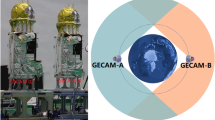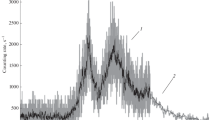Abstract
A multiple pinhole camera system has been designed and proposed for a small satellite of the SAS type for the detection and localization of gamma-ray bursts. The instrument consists of a three unit array of detectors each of which includes a semi-cylindrical collimator surrounding a twodimensional position-sensitive detector. The collimator contains slits of 1 mm width that are cut parallel to the axis of the cylinder. The slits are randomly arranged in azimuth around the cylinder. X-rays may enter the counter through several surfaces. The point at which photoelectric interaction takes place is determined in two dimensions in a plane perpendicular to the cylinder axis. Each unit of the system determines the position of a burst to a great circle. An intersection of two (or three) great circles provides the precise positions.
The field of view of the instrument is 2.7π ster, essentially the entire region of sky not occulted by the Earth. It is designed to operate in the energy range 20–100 keV. An instrument sized to fit a SAS spacecraft has a sensitivity of better than 10−6 erg cm−2 for bursts whose intense phases occur in less than a total of three seconds. For stronger bursts (>10−5 erg cm−2) the location precision is better than a minute of arc.
Similar content being viewed by others
References
Allen, C. W.: 1965,Astrophysical Quantities, Athlone Press: London.
Borkowski, C. J. and Kopp, M. K.: 1972,I.E.E.E. Trans. Nucl. Sci. NS-19.
Cline, T. L. and Desai, U. D.: 1975,Astrophys. J. Letters 196, L43.
Dicke, R. H.: 1968,Astrophys. J. Letters 153, L101.
Metzger, A. E., Parker, R. H., gilman, D., Peterson, L. E., and Trombka, J. L.: 1974,Astrophys. J. Letters 194, L19.
Mertz, L. and Young, N.: 1962, in K. J. Habell (ed.),Optical Instruments, Proc. of London Conference 1961, Chapman and Hall, London.
Palumbo, G. G. L., Pizzichini, G., and Vespignani, G. P.: 1974,Astrophys. J. Letters 189, L9.
Strong, I.: 1974 (private communication).
Wheaton, W., Ulmer, M., Baity, W. A., Datlow, E., Elcan, M., Peterson, L., Klebesadel, R., Strong, I., Cline, E. T., and Desai, J.: 1973,Astrophys. J. Letters 185, L57.
Author information
Authors and Affiliations
Rights and permissions
About this article
Cite this article
Gorenstein, P., Helmken, H. & Gursky, H. Localization of gamma-ray bursts with wide field multiple pinhole camera system in near earth orbit. Astrophys Space Sci 42, 89–97 (1976). https://doi.org/10.1007/BF00645530
Received:
Issue Date:
DOI: https://doi.org/10.1007/BF00645530




